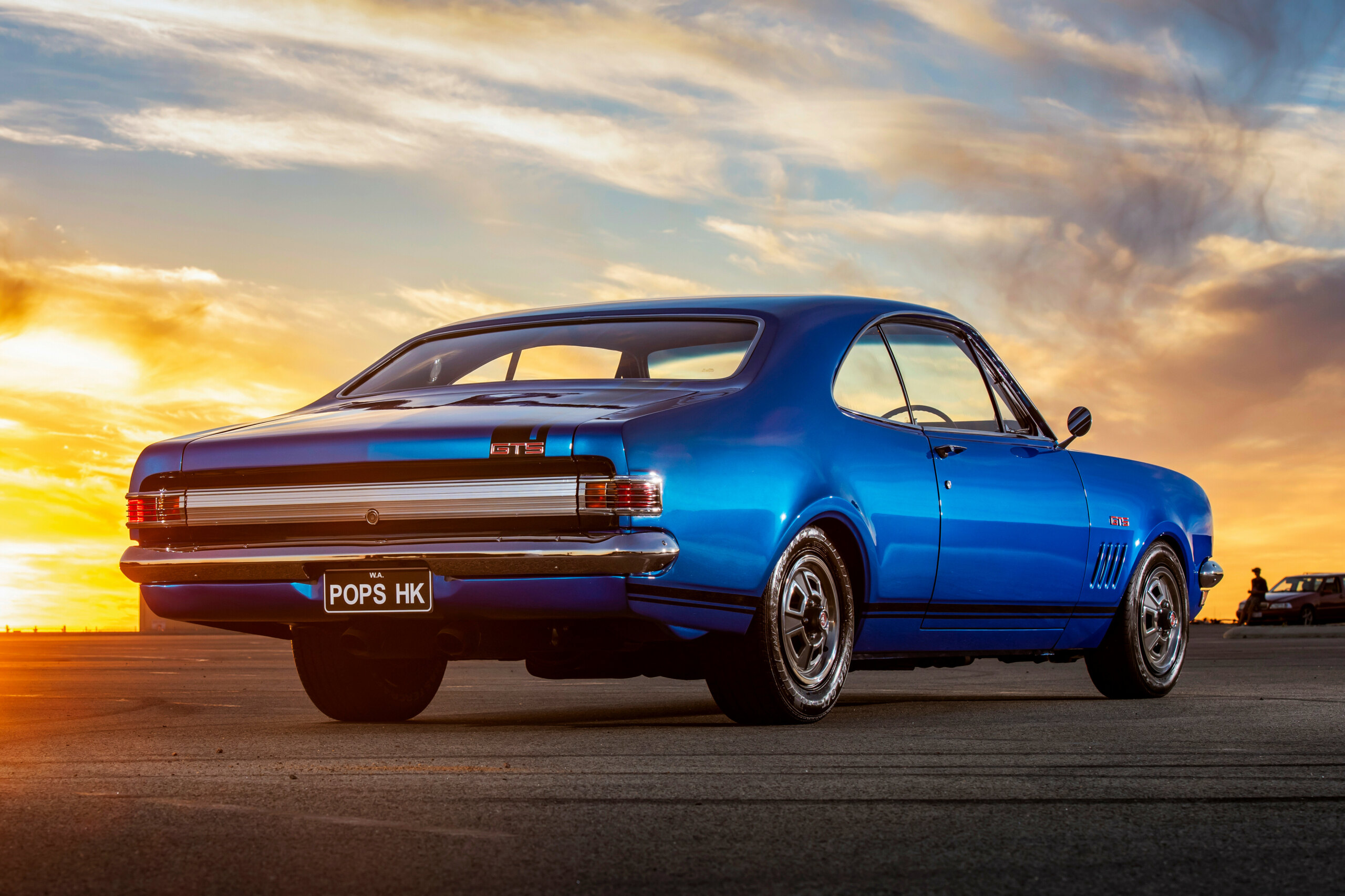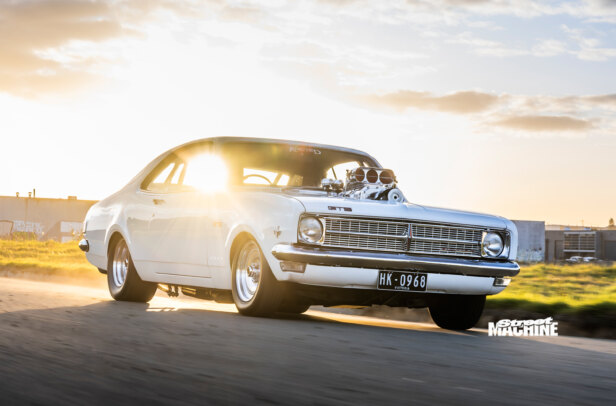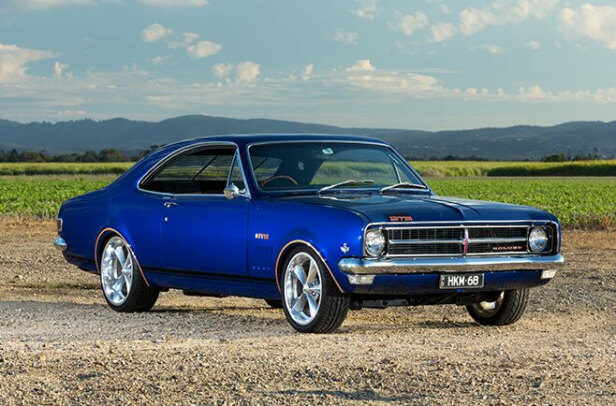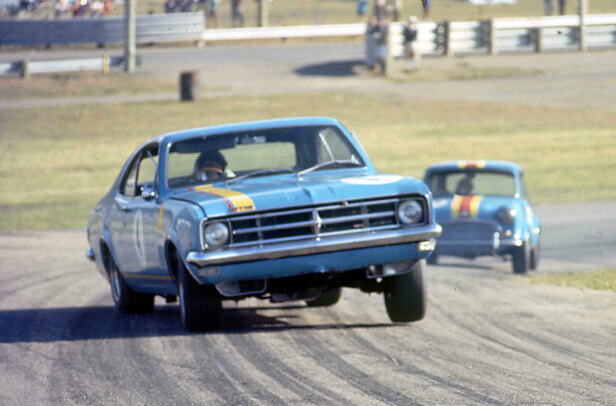You might be wondering what a relatively stock-looking HK Monaro GTS is doing in Street Machine, but there’s a bit more going on with this car than first meets the eye.
First published in Street Machine’s 2022 Yearbook
Father-and-son team John and Travis Oberg have worked together to build this stunning ride. Inspiration came from the elder Oberg; as a young bloke growing up in a small farming town just north of Esperance, WA, John saw a brand-new HK Monaro, and it has been stuck in his mind ever since. Many years later, that cherished memory has been channelled into the car you see before you.
According to Travis, the build philosophy was pretty simple: “Fit a killer engine conversion into a granddad-looking HK Monaro that you would never pick was in there – a wolf in sheep’s clothing with the ability to comfortably drive all day and still smoke the tyres in top gear easily. Our aim was to fit an LSA into an HK with a standard front suspension and flat bonnet. No tubular crossmembers, no rack-and-pinion conversions and definitely no reverse cowls!” Sounds good to us!
As you’re all well aware, the price of Monaros – in fact, any old car – has skyrocketed over the past few years, so the example that John and Travis started with was less than pristine. It was found by a close friend, Dave Campbell, who saw the car advertised locally on Gumtree. “We went to have a look at it and when I saw the condition it was in, I wasn’t very interested,” Travis recalls. “We are mechanical and assembly guys; we don’t really do panel and rust repairs so much. Dave, who is a panel-beating miracle worker, was trying to tell us how good an opportunity it was, so we did a deal with him that if he would do the panel repairs and alignment for us, and get it to a point where a panel shop could prepare it for paint, we would go ahead with the project.”
As you can see from the photos, the project did go ahead and is now a far cry from the rolling wreck they started with, thanks to the masterful work of both Dave and the team of Charlie and Erik Takacs, who finished off the bodywork and laid on the flawless paint. The end result is a breathtaking, beautifully finished car both inside and out.
If you’ve looked at the engine bay pics already, you’ve no doubt noticed how neat and tidy it is, and it’s not just because they painted the inner guards and firewall body colour instead of satin black. “Normally the HKs have a bracket between the booster and the firewall,” Travis explains. “We took that out and sunk the booster flush against the firewall, which tidies it up heaps.
HKs also have a lot of little ripples in the engine bay; they were all taken out to tidy it up, and we tried to make it as symmetrical as possible as well.” Even the LSA engine cover was tweaked. They normally have holes for the intercooler hosing and the like, but Travis got another cover and plastic-welded filler pieces to tidy up all of the holes and cut-outs.
The other body modification, which hardly anyone would ever pick, is the underside of the bonnet. Plenty of work went into grafting an HQ bonnet frame onto the HK bonnet to ensure the LSA would fit without any scoops, bulges or reverse cowls. “Charlie and Erik cut the HQ frame into about 38 pieces and then blended it in to look factory,” Travis says. Some modification to the front crossmember dropped the engine down about 20mm; changing the bonnet frame extended that clearance to 25mm, as there’s an open spot in the middle of the HQ bonnet where you’d usually find bracing on the HK version. “Also, with a small-block, the pipes hang down quite low, but with an LS the pipes sit a bit higher, so you can drop the engine down and you still have heaps of clearance,” Travis says.
While the Obergs have built and raced plenty of cars with tough, cast-iron small- and big-block engines both aspirated and supercharged, lately Travis has gone with a bit of a pro tourer vibe, having just completed an HG panel van with an LS2, 4L60E and nine-inch. So the LSA crate engine was an easy choice for the HK, and was pretty cheap when they bought it a few years back. However, being racers at heart, John and Travis couldn’t just chuck it in bog-stock.
Instead, the engine was sent off to Blown Motorpsorts, where George Separovich and Simon Giles gave it a bit of a tickle-up with some Deatschwerks injectors and a pulley kit that makes the blower pump 18psi into the engine, resulting in 555hp at the tyres. There’s a Paul Rogers Turbo 350 behind it, along with a nine-inch with a fabbed housing, 3.55 gears and a Truetrac, all trying their hardest to get the power to the ground.
Unlike many builds, the paint choice for the HK was a no-brainer, as the car John remembered from his childhood was blue. “We chose Voodoo Blue, a VE Commodore colour, as an offshoot of the late-model engine choice,” Travis says. “We feel there are few late-model metallic colours that suit the shape of a late-60s car, but this colour seems to suit it very well.” You won’t get any argument from me; the colour brings out the curves beautifully and looks stunning under any type of lighting.
When it came to the interior, there wasn’t much to start with – just a set of seat frames and not much else. Rod Brown Motor Trimmers fitted a Winner Products interior in the original black trim, and apart from the neatly fitted B&M shifter, it’s just as it would have been in 1968.
The final touch was the wheels, and once again, while they might look like stockies, they’re actually 15×7 and 15×8.5 steelies modified to allow fitment of the original hubcaps. “With the worry of having to chase the rear hubcaps down the road when putting the power down, we built adapters that bolt to longer rear wheel studs,” Travis explains. “The steel wheel bolts on, and then a fabricated plate bolts on the outside of the wheel nuts, with studs taking the place of the dummy wheel nuts on the hubcap, meaning the hubcap is attached to the steel wheel and cannot fly off when getting into the throttle.”
This is definitely one of those cars where the more you look, the more you see. With the current street machining trend of cars that look relatively stock while packing some punch in the driveline, it’s a good reminder to not judge a book by its cover.
Take your time, soak in all the details – otherwise you might find yourself missing out on some really neat ideas.
JOHN AND TRAVIS OBERG
1968 HK HOLDEN MONARO
| Paint: | PPG Voodoo Blue |
|---|---|
| DONK | |
| Type: | LSA crate motor |
| Inlet: | Standard |
| ECU: | Cadillac CTS-V |
| Blower: | Eaton 1.9L |
| Heads: | Standard |
| Valves: | 2.16in (in), 1.59in (ex) |
| Cam: | 198/216 [email protected], .492/.480 lift |
| Pistons: | Hypereutectic, 9.1:1 compression |
| Crank: | Standard forged |
| Conrods: | Standard |
| Radiator: | Custom aluminium, Mondeo fans |
| Exhaust: | 17/8in primaries, four-into-one headers, twin 2.5in pipes |
| Ignition: | Standard |
| SHIFT | |
| Gearbox: | TH350 |
| Converter: | Dominator 3200rpm stall |
| Diff: | 9in, 3.55:1 gears, Truetrac |
| BENEATH | |
| Front: | King Springs, Koni adjustable shocks |
| Rear: | 3in-lowered leaf springs, Koni adjustable shocks |
| Steering: | Standard |
| Brakes: | VT Commodore discs (f), HQ drums (r) |
| ROLLING STOCK | |
| Rims: | Steelies; 15×7 (f), 15×8.5 (r), modified to fit 14in hubcaps |
| Rubber: Maxxis | 195/70R15 (f), Mastercraft 245/50R15 (r) |
THANKS
Dave Campbell for ongoing assistance and advice; Charlie and Erik Takacs for body finishing and painting; Brad at All Class Re-wiring for wiring assistance; Rod Brown for the interior trim; Bruce at BMH Trikes for fabricating the one-off pieces; Dicker’s Speed Shoppe for fittings and parts; George and Simon at Blown Motorsports for tuning and blower mods; Castlemaine Auto Electrics for electrical and engine harness support; John’s wife Carolyn and Travis’s wife Bree and kids Marlee and Cruz for their ongoing support.




Comments